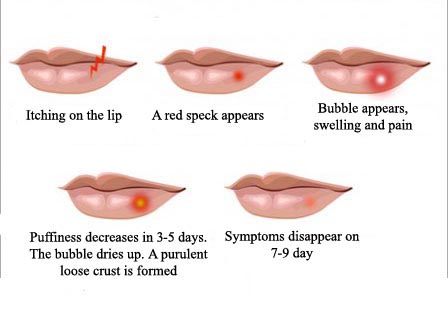Herpes Simplex

Published: 18 Jun 2025
ICD9: 054.9 ICD10: B00.9 ICD11: 1F00.Z
Herpes simplex is a viral infection caused by the herpes simplex virus (HSV).
There are two main types:
![]() HSV-1: Typically associated with oral herpes, causing cold sores or fever blisters around the mouth. However, it can also cause genital herpes.
HSV-1: Typically associated with oral herpes, causing cold sores or fever blisters around the mouth. However, it can also cause genital herpes.
![]() HSV-2: Primarily associated with genital herpes, causing sores on the genitals, buttocks, or inner thighs. However, it can also cause oral herpes.
HSV-2: Primarily associated with genital herpes, causing sores on the genitals, buttocks, or inner thighs. However, it can also cause oral herpes.
Key characteristics of herpes simplex:
![]() Highly contagious: Spread through direct contact with sores or the virus, even when sores aren't present (asymptomatic shedding).
Highly contagious: Spread through direct contact with sores or the virus, even when sores aren't present (asymptomatic shedding).
![]() Lifelong infection: Once infected, the virus remains in the body, even after sores heal. It can reactivate and cause outbreaks.
Lifelong infection: Once infected, the virus remains in the body, even after sores heal. It can reactivate and cause outbreaks.
![]() Symptoms:
Symptoms:![]()

![]() Outbreaks: Painful blisters or sores that may tingle, itch, or burn before appearing.
Outbreaks: Painful blisters or sores that may tingle, itch, or burn before appearing.![]()

![]() Flu-like symptoms: Fever, swollen lymph nodes, headache, and fatigue during the initial outbreak.
Flu-like symptoms: Fever, swollen lymph nodes, headache, and fatigue during the initial outbreak.![]()

![]() Asymptomatic shedding: Virus is present and contagious without causing any visible symptoms.
Asymptomatic shedding: Virus is present and contagious without causing any visible symptoms.
![]() Triggers for outbreaks: Stress, illness, sunlight exposure, hormonal changes, or weakened immune system.
Triggers for outbreaks: Stress, illness, sunlight exposure, hormonal changes, or weakened immune system.
![]() Treatment: Antiviral medications can help reduce the frequency, duration, and severity of outbreaks, as well as decrease the risk of transmission. There is no cure for herpes.
Treatment: Antiviral medications can help reduce the frequency, duration, and severity of outbreaks, as well as decrease the risk of transmission. There is no cure for herpes.
Important considerations:
![]() Genital herpes can be transmitted to a baby during childbirth, which can cause serious health problems for the newborn.
Genital herpes can be transmitted to a baby during childbirth, which can cause serious health problems for the newborn.
![]() People with weakened immune systems may experience more frequent and severe outbreaks.
People with weakened immune systems may experience more frequent and severe outbreaks.
![]() Herpes can increase the risk of contracting or transmitting HIV.
Herpes can increase the risk of contracting or transmitting HIV.
If you suspect you have herpes, it's important to see a healthcare professional for diagnosis and treatment.